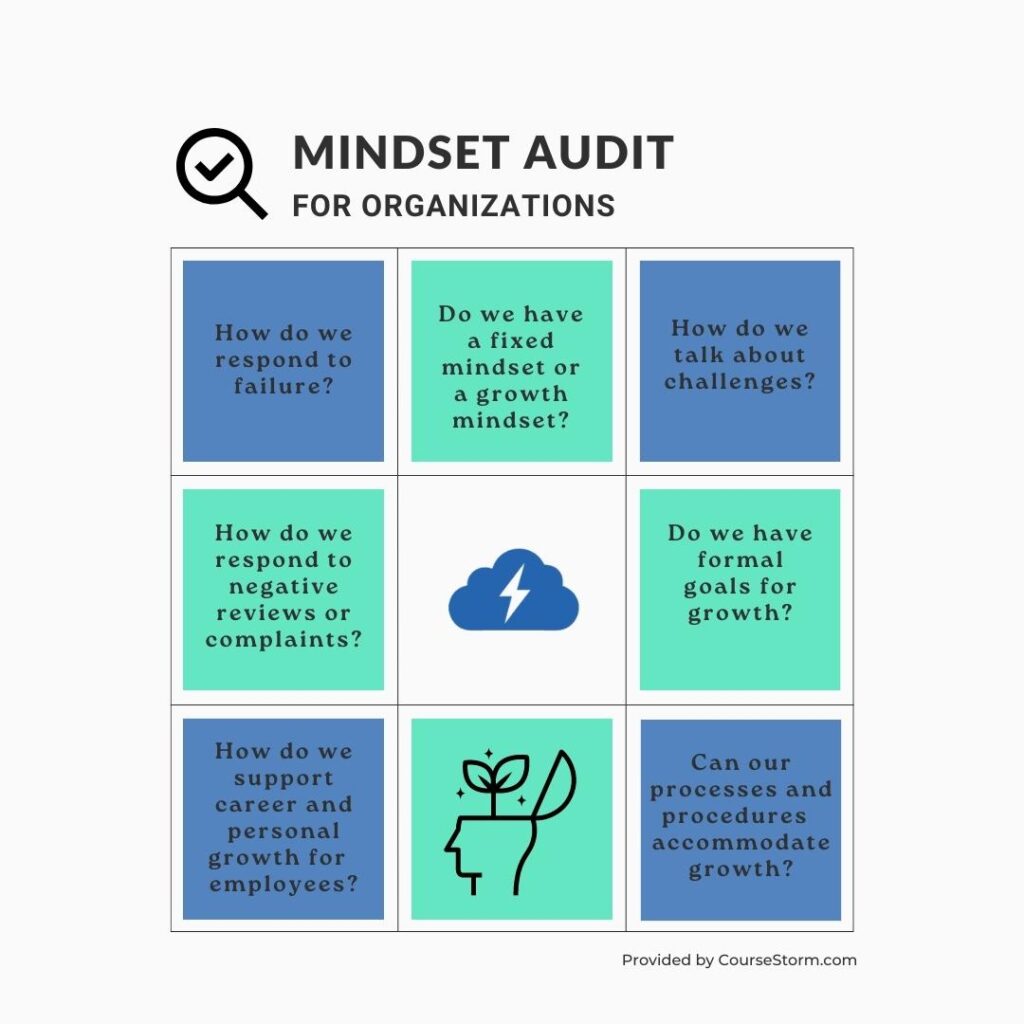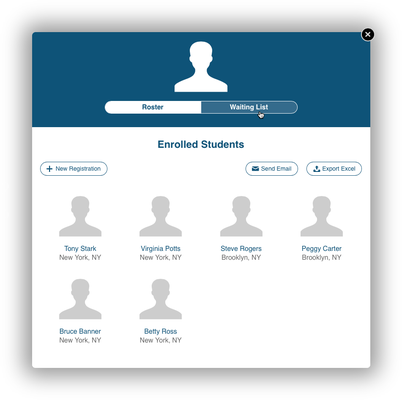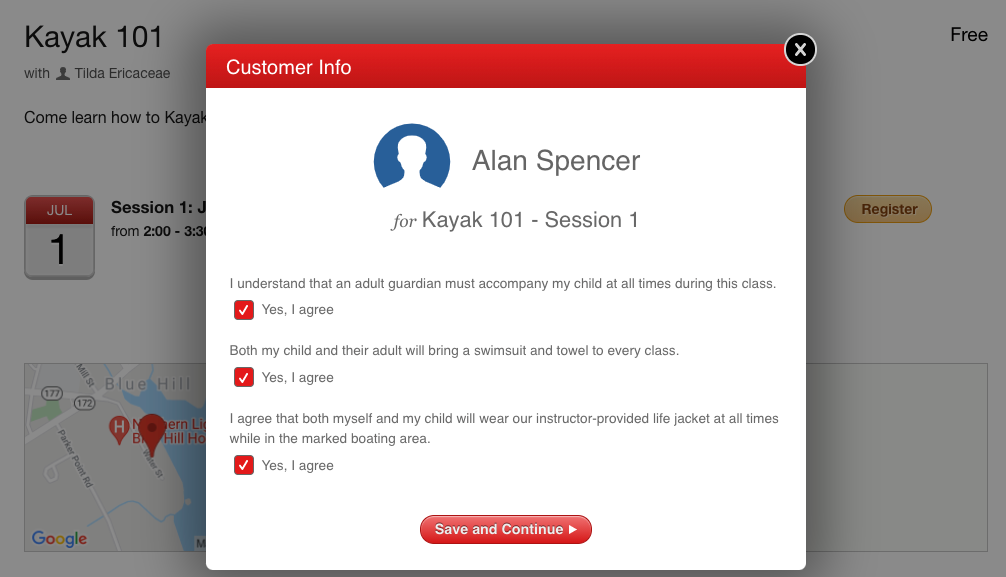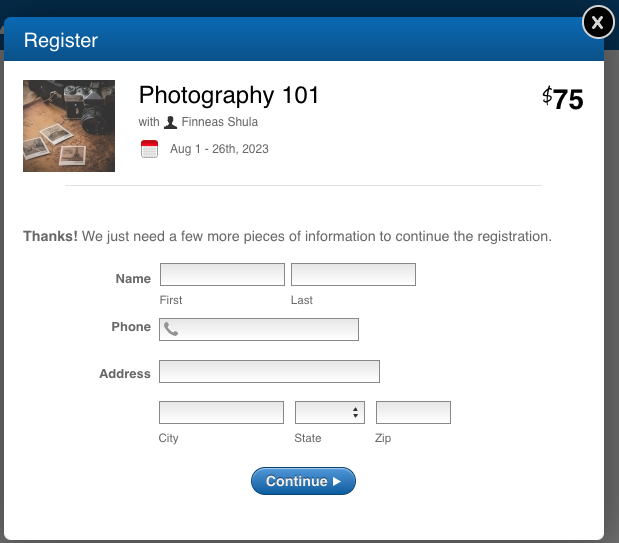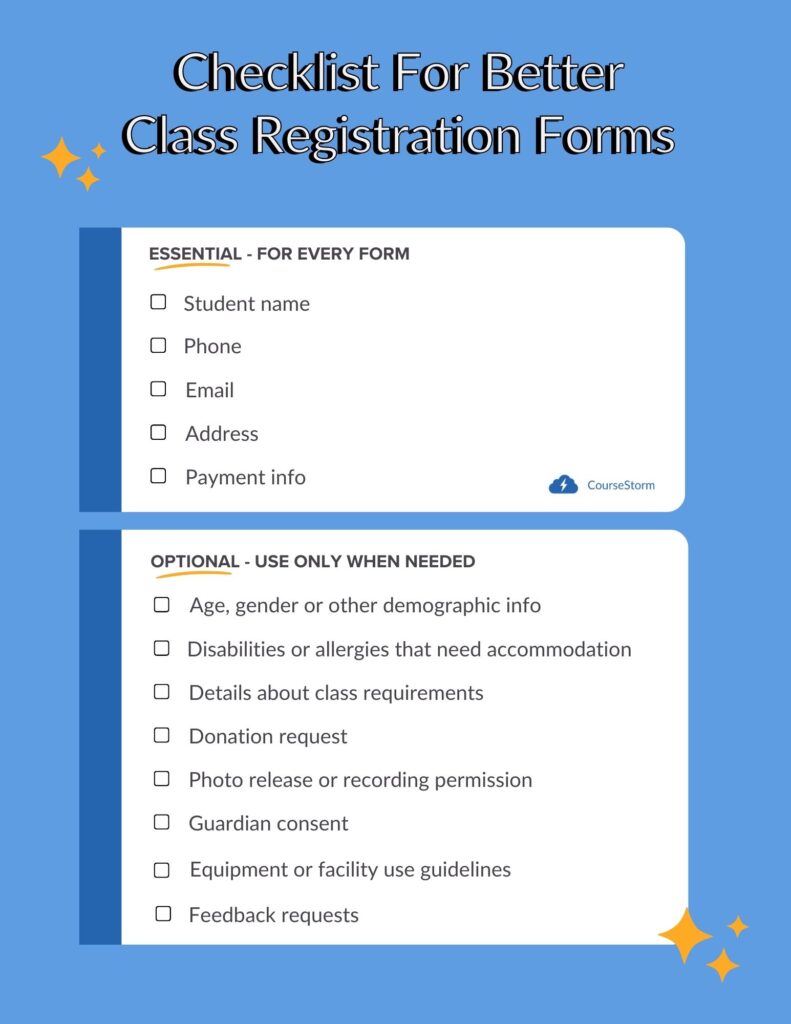9 Key Elements of a Course Catalog: Examples That Boost Enrollment
Leave a CommentBuilding a quality course catalog can help you convince more students to register. The most effective course listings are more than a simple list. They combine all of the information students need to know to make an informed decision about your courses.
We see a lot of course guides in our work with community and arts education programs. Among the hundreds we’ve seen, a few stand out as strong course catalog examples that other programs could emulate. You can use these examples as a model as you build your own course listings and to avoid common pitfalls. We’ll even break down each one so you can see what makes them effective.
What Is a Course Catalog for?
You may think that a course catalog is a list of classes offered by your program or organization. What people sometimes forget is that a quality course catalog is also a marketing tool. Students use it to decide which classes to take and whether those classes are worth their time and money.
To be effective, your course catalog must capture the eye and the imagination of your potential students. It needs to convince them to register right now.
Potential students who browse a course catalog are looking for answers to two important questions:
- What will this class teach me?
- Is the value of this class worth my investment of time and money?
Many programs struggle because they stop after answering question one. They tell students about subject matter and learning outcomes, but fail to explain why those outcomes matter. As a result, students know what the class is about, but may not see the true value in the experience.
An effective course catalog convinces students of the value of each class. It uses every course title, description, and image to show students what they can get by taking the course.
9 Parts of an Effective Course Catalog, With Examples
An effective course catalog includes 9 parts. Each one helps the student gather information about the courses offered.
- Categories
- Subcategories
- Class names
- Class descriptions
- Images
- Instructor information
- Place and time
- Pricing
- Registration link
Below, the course catalog example from San Juan College Community Enrichment shows all 9 parts in action.
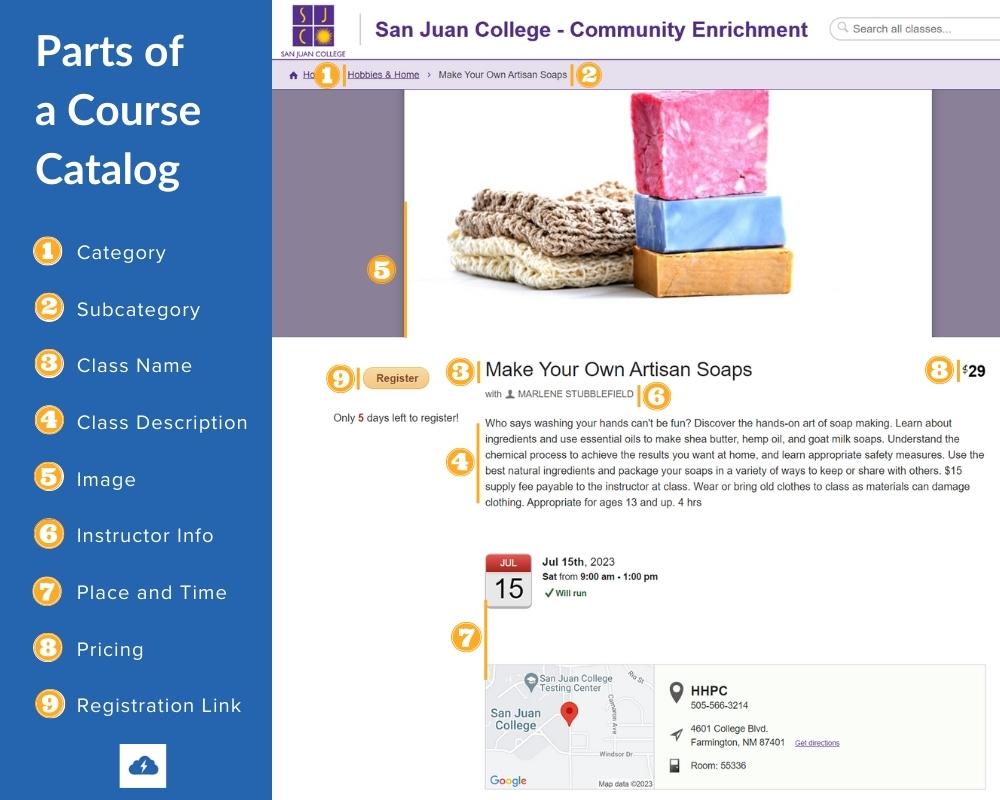
1. Categories: What Is This Course About?
Categories help to group similar kinds of classes and make it easy for people to find the classes they’re looking for. Seek a balance between overly generic and too specific. The goal is to logically group clusters of related classes.
Some categories that are broad, yet specific enough to be useful may include:
- Kids classes
- Workforce development
- Fitness
- Finance
- Music and dance
- Arts and crafts
- Computer skills
- Cooking
For example, the category “Cooking” is precise. Someone can easily imagine the kinds of classes that might fit into that category. It’s also broad enough to include several different classes. Something like “French Cuisine” may be too specific, unless you run a cooking school.
2. Subcategories Make Navigation Easier
Subcategories can break down big topics into more specific focus areas. This helps students find the classes they are looking for by guiding them through your course catalog.
For example, you may have 30 classes in workforce development that focus on 5 or 6 subtopics. Categories can help students find the courses that are most relevant to them.
Some example subcategories for workforce development might be:
- Computers & technology
- Healthcare & medical
- Entrepreneurship
- Financial literacy
- Skilled trades
3. Class Names Tell Students What to Expect
Effective class names tell students what the class is about. When writing class names, aim for clear description over cleverness. Here are a few examples of real class names that work:
- Digital Photography: Capturing the Right Shot
- Write From the Heart for Fun and Profit
- Five Unexpected Books Every Classical Educator Should Read: Free Webinar
- Websites That Work: Converting Web Visitors Into Customers
These class names work because they’re clear and include keywords that search engines can find. Some also include extra details about format or cost.
Of course, if you can be clear and clever, that’s even better. One CourseStorm customer put this idea into action for her “Learn to Crochet” class. Last year, the class was canceled due to lack of registrations. Instead of overhauling the class, she changed the name. This year, she quickly filled the class “Too Legit to Knit: Crochet Instead.”
Pro Tip: If you run the same class every season, keep the name the same in each version of the catalog. (Unless you’re hoping to revitalize a lagging class!) This helps students recognize classes they’ve already taken and spot new ones on their preferred topics.
4. Descriptions With Real Course Catalog Examples
Course descriptions tell students what they’ll learn and why they should take a course. Focus on the real effect the course could have on their life. Writing a quality course description takes some effort, but the results are worth it.
Here’s an example of a real course description from The Training Place:
“If there’s one thing guaranteed in life, it is change. The way in which we navigate unanticipated change and stressful experiences will have a direct impact on our mind and body in subtle and not so subtle ways.
You will be introduced to the Change RHYTHM model, explore the tone of your inner narrative, self-assess your relationship and mindset towards a recent change event, and define a set of unique resilience rituals that will enable you to adapt to and evolve through the change and maintain forward momentum in the new normal that follows.”
This course description works because it:
- Speaks to a real need the student has — dealing with change.
- Explains exactly what students will learn.
- Includes a clear outcome: “adapt to and evolve through the change and maintain forward momentum in the new normal that follows.”
Pro Tip: If you realize you need to share more information than can comfortably fit in a course description, consider linking to a course fact sheet or FAQ attachment.
Keywords: the Hidden Element of a Course Catalog
Using key search terms in your course titles and descriptions makes them more discoverable to search engines. That helps your students find what they’re looking for.
You can do some basic keyword research using a tool like Semrush or Moz. Then, include those keywords in your course descriptions. Aim for a good mix of the two main types of keywords:
- short-tail keywords are short and broad, such as “classes for adults” or “First Aid class”
- long-tail keywords are longer and more specific, like “sustainable papermaking course for adults” or “Lego robot workshop for teens”
Include both so search engines can see what your course is really about and who it’s for.
5. Images Increase Engagement
Images make your course listings seem more inviting. The best option is to use real photos from your courses. If that’s not possible, high-quality stock images or custom graphics can fill the gap.
Look for images that are easy to understand at a glance. Smiling faces and bright colors tend to be most engaging. Remember to use images that include all the types of people who might take your classes.
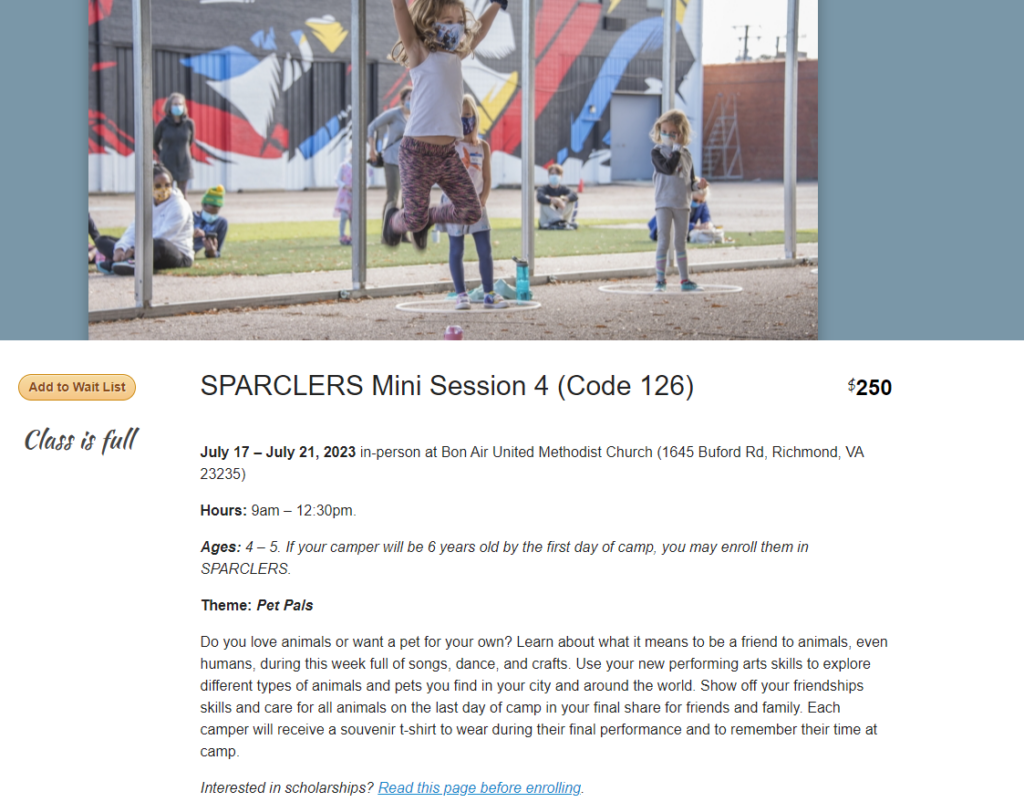
6. Instructor Information Boosts Student Confidence
Information about the instructor can provide a compelling reason to take a class. Include a paragraph about the instructor and their background, or link to their bio elsewhere on your site.
7. Place and Time Help Orient Students
Include information about when and where the class will run, so students can tell if it fits their schedule. Remember to mention whether a class is online or in-person.
8. Pricing Information Is Essential
Include clear pricing information for every class. Make sure you’re accurately portraying the whole cost of the program. Some students may love to take an art class for $300, but when they find out they have to spend another $300 to buy their own supplies, the course no longer fits their budget. It will save both your time and theirs to be forthright about pricing.
For big-ticket courses, consider offering payment plans to make them more accessible. Being open about pricing helps build trust and gives students the information they need to make an informed decision.
9. Registration Links Let Students Act Now
Every class listing should include a button or link where students can register right away. This makes it easy for someone to act while interest is high.
Using online registration software with payment processing streamlines enrollment for students and for you. After registering online, all they have left to do is show up for class!
Avoid This Major Course Catalog Mistake!
Some programs can get all 9 parts right and still not see the number of registrations they were hoping for. Why? Because they’re requiring an account before letting someone view their course catalog.
We’ve all had the experience of trying to read an online article only to be informed that we need to create an account first. Not only does this interrupt the natural flow for the user, but it also makes them mistrustful. They wonder, “Do you even want me to read your content, or do you just want my contact information so you can bombard my inbox with sales emails?”
Your class offerings aren’t confidential information—in fact, the more people who know about them, the better! Making your course catalog accessible to all gives students the chance to discover a class that’s a perfect fit for them.
Quick fix: Share your course catalog openly and freely. Make sure the link routes visitors directly to the catalog without a login.
Course Catalog Examples: How It All Fits Together
A well-organized course catalog is inviting. Whatever organizational structure you choose to guide your layout should be consistent throughout. For example, you may choose to list your classes alphabetically, or you may choose to list them based on when they run, or you may choose to list them by type category.
However you organize, make sure the course catalog is searchable. Bonus points if you can allow students to adjust how courses are sorted so they can view them by date, price, or alphabetically by title.
CourseStorm offers everything you need to build your own course catalog like the examples shared here. To learn more, start your free trial or contact us today.




